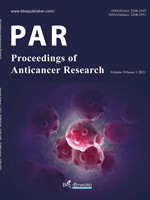Abstract
Objective: To investigate the effect of sorafenib combined with interferon-lambda 3 on the growth of liver cancer transplanted into nude mice. Methods: Female nude mice of 4-5 weeks of age that passed quarantine were selected and fed for 1-2 weeks before experimental operation. The cell suspension of human hepatoma cell line SMMC-7721 was inoculated into the right cervical axillary fossa with a syringe. The tumor-bearing mice were randomly divided into a control group and an experimental group. The control group received normal saline whereas the experimental group was further divided into three other groups: IFN-lambda 3 treatment group, sorafenib treatment group, and IFN-lambda 3 combined with sorafenib treatment group. The situation of nude mice was analyzed. At the end of the experiment, the volume of allogeneic transplanted tumor was measured, and the morphology of tumor cells, the expression of proliferating protein Ki-67, as well as the number of apoptotic cells were observed by hematoxylin and eosin (H&E) staining, immunohistochemistry (IHC), and TUNEL staining. Results: The tumor cell volume of the IFN-lambda 3 treatment group, sorafenib treatment group, and IFN-lambda 3 combined with sorafenib treatment group decreased, which was statistically significant compared with the control group (p < 0.05). The increment rate of proliferating protein Ki-67 in the transplanted tumor tissue of the three drug groups was significantly lower than that of the control group (p < 0.05). IFN-lambda 3 combined with sorafenib had the greatest effect on the expression level of Ki-67 protein. Compared with the control group, the expression rate was significantly lower (p < 0.05). In terms of cell apoptosis, IFN-lambda 3 and/or sorafenib, as well as the combination of the two, showed statistically significant differences compared with the control group (p < 0.05). The rate of cell apoptosis was the highest in the IFN-lambda 3 combined with sorafenib group. Conclusion: IFN-lambda 3 combined with sorafenib can inhibit the growth and proliferation of human hepatocellular carcinoma cells in nude mice and promote the apoptosis of hepatocellular carcinoma cells, which proves that IFN-lambda 3 combined with sorafenib can treat hepatocellular carcinoma in vivo.
References
Hu J, Wang Q, Liu Y, 2021, Research Progress on Proteasome Subunits in Regulating Occurrence and Development of Hepatocellular Carcinoma. Zhejiang Da Xue Xue Bao Yi Xue Ban (Journal of Zhejiang University Medical Sciences), 50(3): 396-402. doi: 10.3724/zdxbyxb-2021-0146
Kanwal F, Hoang T, Kramer JR, et al., 2011, Increasing Prevalence of HCC and Cirrhosis in Patients with Chronic Hepatitis C Virus Infection. Gastroenterology, 140(4): 1182-1188.e1. doi: 10.1053/j.gastro.2010.12.032
Zhang W, Zhang B, Chen X, 2021, Adjuvant Treatment Strategy After Curative Resection for Hepatocellular Carcinoma. Frontiers of Medicine, 15(2): 155-169. doi: 10.1007/s11684-021-0848-3
Wang J, Li J, Tang G, et al., 2021, Clinical Outcomes and Influencing Factors of PD-1/PD-L1 in Hepatocellular Carcinoma. Oncology Letters, 21(4): 279. doi: 10.3892/ol.2021.12540
Waidmann O, 2018, Recent Developments with Immunotherapy for Hepatocellular Carcinoma. Expert Opinion on Biological Therapy, 18(8): 905-910. doi: 10.1080/14712598.2018.1499722
DeLeon TT, Zhou Y, Nagalo BM, et al., 2018, Novel Immunotherapy Strategies for Hepatobiliary Cancers. Immunotherapy, 10(12): 1077-1091. doi: 10.2217/imt-2018-0024
Zeng Z, Lu Q, Liu Y, et al., 2021, Effect of the Hypoxia Inducible Factor on sorafenib Resistance of Hepatocellular Carcinoma. Frontiers in Oncology, 11: 641522. doi: 10.3389/fonc.2021.641522
Bruix J, Takayama T, Mazzaferro V, et al., 2015, Adjuvant Sorafenib for Hepatocellular Carcinoma After Resection or Ablation (STORM): A Phase 3, Randomised, Double-Blind, Placebo-Controlled Trial. Lancet Oncol, 16(13): 1344-1354. doi: 10.1016/S1470-2045(15)00198-9
Qin S, Wang J, Zhou C, et al., 2019, The Influence of Interleukin 28B Polymorphisms on the Risk of Hepatocellular Carcinoma Among Patients with HBV or HCV Infection: An Updated Meta-Analysis. Medicine, 98(38): e17275. doi: 10.1097/MD.0000000000017275
Muñoz-Martínez S, Iserte G, Sanduzzi-Zamparelli M, et al., 2021, Current Pharmacological Treatment of Hepatocellular Carcinoma. Current Opinion in Pharmacology, 60: 141-148. doi: 10.1016/j.coph.2021.07.009
Qin S, Ren Z, Fen YH, et al., 2021, Atezolizumab Plus Bevacizumab Versus Sorafenib in the Chinese Subpopulation with Unresectable Hepatocellular Carcinoma: Phase 3 Randomized, Open-Label IMBrave150 Study. Liver Cancer, 10(4): 296-308. doi: 10.1159/000513486
Cao Y, Ouyang T, Xiong F, et al., 2021, Efficacy of Apatinib in Patients with Sorafenib-Transarterial Chemoembolization Refractory Hepatocellular Carcinoma: A Retrospective Study. Hepatology International. doi: 10.1007/s12072-021-10198-3
Hang L, Yan ZP, Hou ZH, et al., 2021, Neutrophil-to-Lymphocyte and Platelet-to-Lymphocyte Ratios as Predictors of Outcomes in Patients with Unresectable Hepatocellular Carcinoma Undergoing Transarterial Chemoembolization Plus Sorafenib. Front Mol Biosci, 8: 624366. doi: 10.3389/fmolb.2021.624366
Subhajit R, Debarati GR, Anand B, et al., 2021, Functional Genetic Variants of the IFN-?3 (IL28B) Gene and Transcription Factor Interactions on Its Promoter. Cytokine, 142: 155491. doi: 10.1016/j.cyto.2021.155491
Kusano H, Ogasawara S, Akiba J, et al., 2013, Antiproliferative Effects of Sorafenib and Pegylated IFN?2b on Human Liver Cancer Cells In Vitro And In Vivo. International Journal of Oncology, 42(6): 1897-1903. doi: 10.3892/ijo.2013.1904
